Understanding Qualcomm's Snapdragon 810: Performance Preview
by Joshua Ho & Andrei Frumusanu on February 12, 2015 9:00 AM EST- Posted in
- SoCs
- Qualcomm
- Mobile
- Gobi
- Snapdragon 810
GPU Performance
Last but certainly not least, we have GPU performance. As we mentioned earlier, the Snapdragon 810 introduces Qualcomm's Adreno 430, the latest member of the Adreno 400 GPU family. Qualcomm's own performance estimates call for a 30% increase over Adreno 420, with a final GPU clock of 600MHz being identical to the Snapdragon 805's (Adreno 420) own GPU clock speed.
From an architectural standpoint Adreno continues to be something of a black box for us. Other than being a modern OpenGL ES 3.1/AEP design, we don't know too much about how the GPU is laid out, and Qualcomm's current legal battle with NVIDIA likely not helping matters. In any case, Qualcomm has indicated that Adreno 430 is not just a simple extension of Adreno 420, so we may be looking at an architectural change such as wider shader blocks.
For today's benchmarks, as we mentioned before we only had a limited amount of time with the Snapdragon 810 and had issues with BaseMark X. We've had to pare down our GPU benchmarks to just 3DMark 1.2 and GFXBench 3.0. Once we get final hardware in, we will be able to run a wider array of graphics benchmarks on Snapdragon 810.
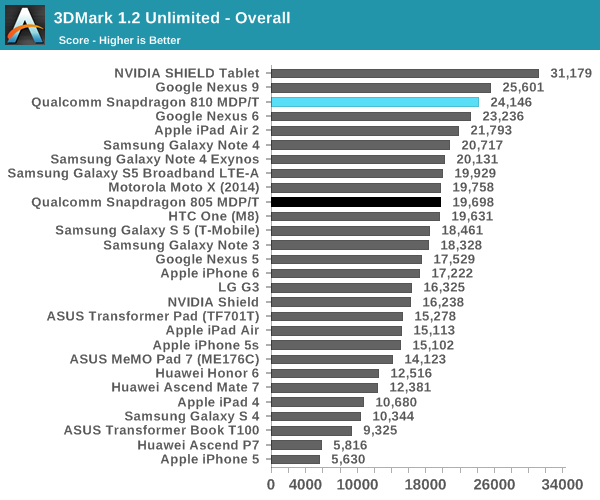
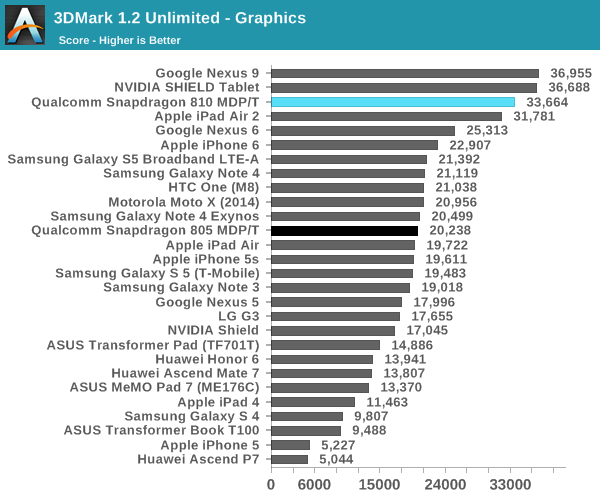
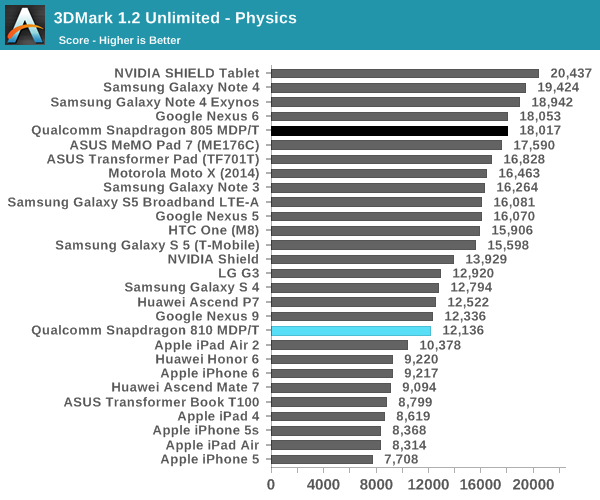
Starting off with 3DMark, compared to the Snapdragon 805 reference platform the actual graphics performance advantage is even greater than 30%, coming in at closer to 65%. However since drivers play a big role in this, a more recent 805 platform like the Nexus 6 may be a better comparison point, in which case the gains are 33%, just a hair over Qualcomm's own baseline performance estimate. We also find that Snapdragon 810 oddly struggles at physics performance here, underperforming Snapdragon 805 devices, something the Exynos 5433 didn't have trouble with. As a result overall performance is only slightly improved over the Nexus 6.
Continuing with GFXBench, we look at more pure GPU loads. One has to take note that the MDP/T employs a 4K screen resolution, and the on-screen results will likely suffer from that.

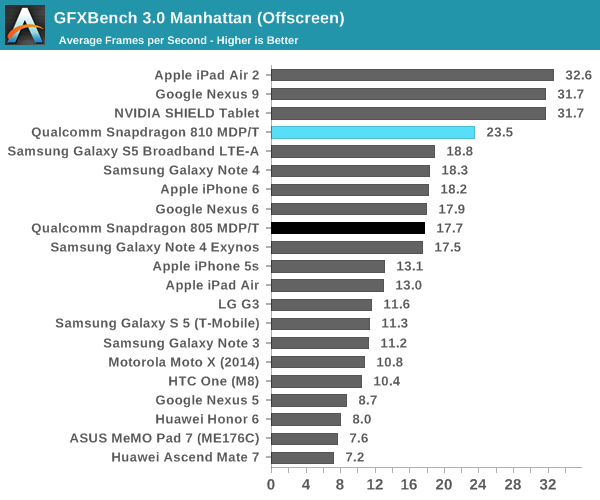
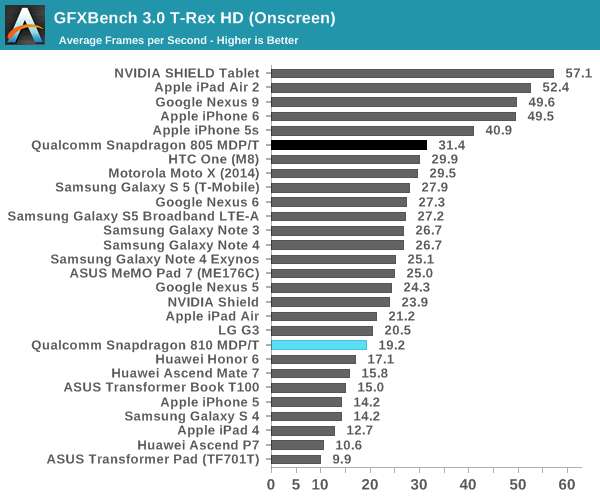
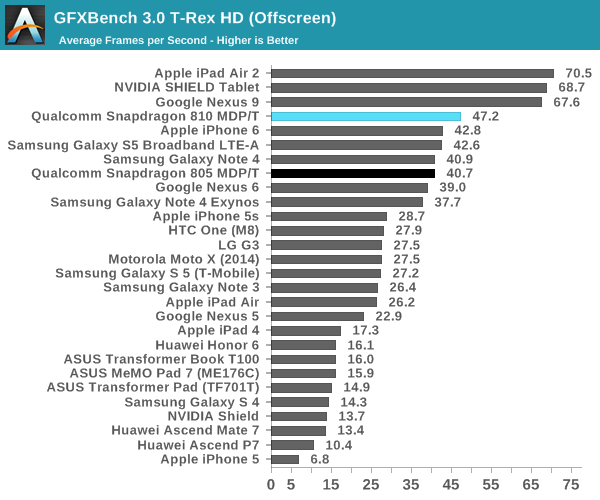
Under GFXBench 3.0's full rendering tests of Manhattan and T-Rex, the Snapdragon 810 continues to show considerable performance gains over the Snapdragon 805. Ignoring the onscreen results for now since the Snapdragon 810 reference platform runs at such a high resolution, offscreen results show the 810 outperforming the 805 by 33% in Manhattan and 16% in T-Rex. The former is again well in-line with Qualcomm's performance estimate, wile the older T-Rex benchmark doesn't show the same gains, possibly indicating that Adreno 430's biggest gains are going to come from shader-bound scenarios.
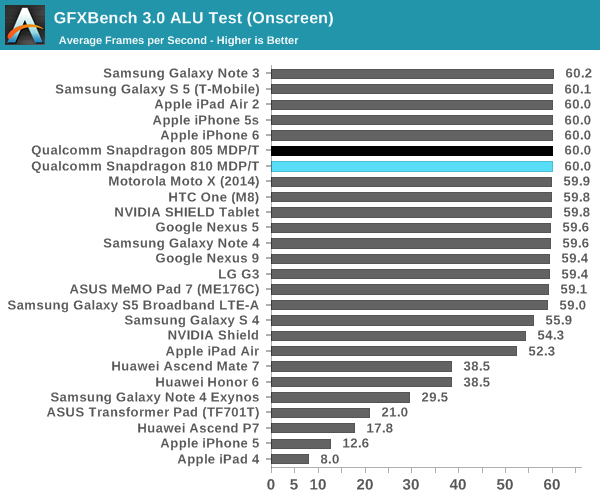
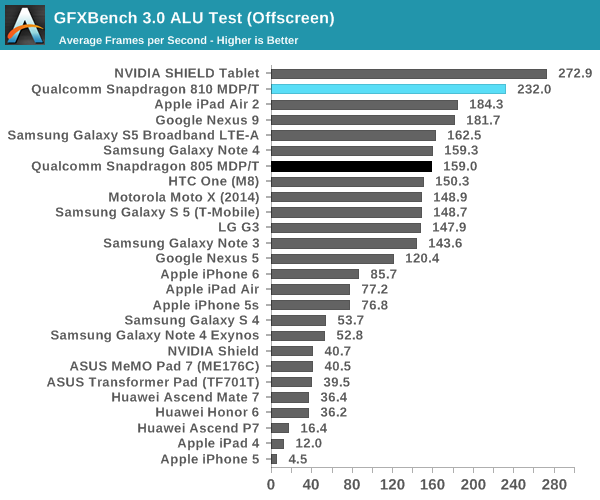

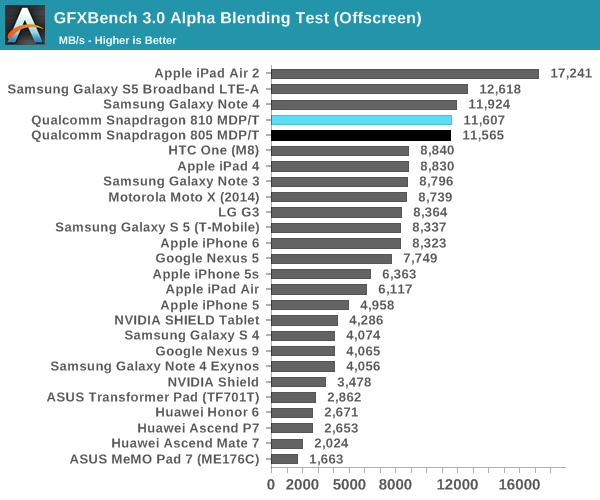
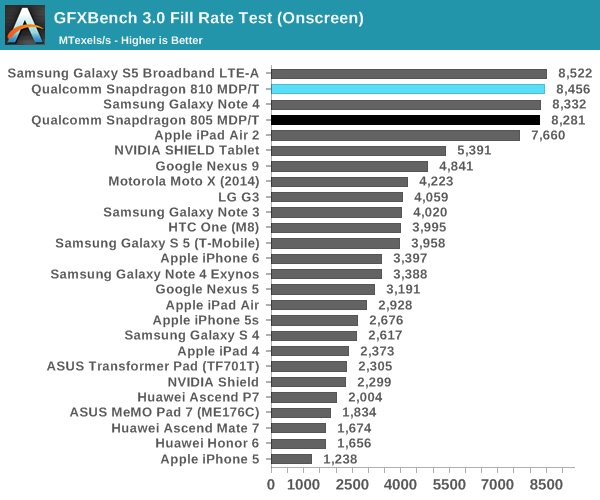
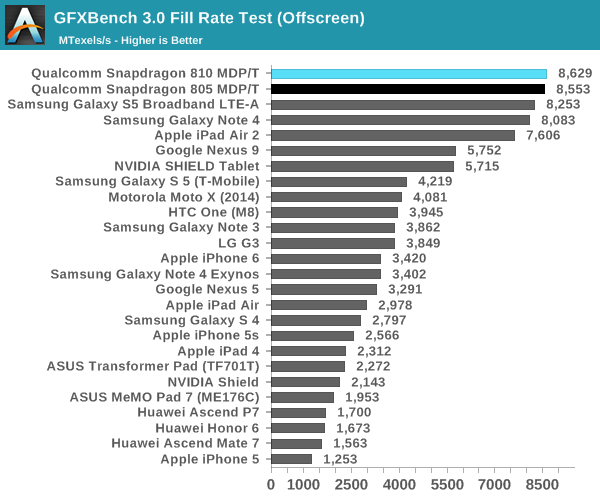
Meanwhile GFXBench's synthetic tests continue to put Adreno 430 and the Snapdragon 810 in a good light. ALU performance in particular is showing very large gains - 46% better than the Snapdragon 805 and Adreno 420 - while our blending and fillrate tests show almost no gain over Snapdragon 805. This adds further credence to our theory that Qualcomm has widened or otherwise improved Adreno's shader blocks for 430, as other elements of the GPU are not showing significant performance changes.
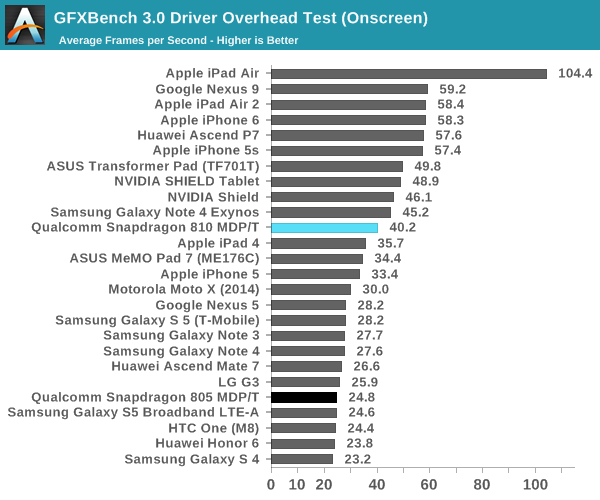
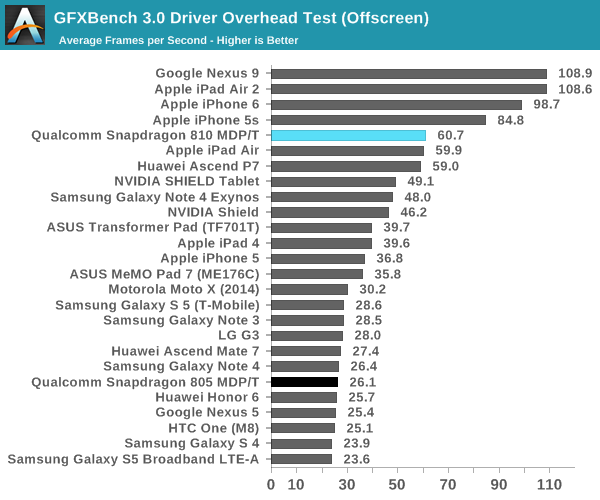
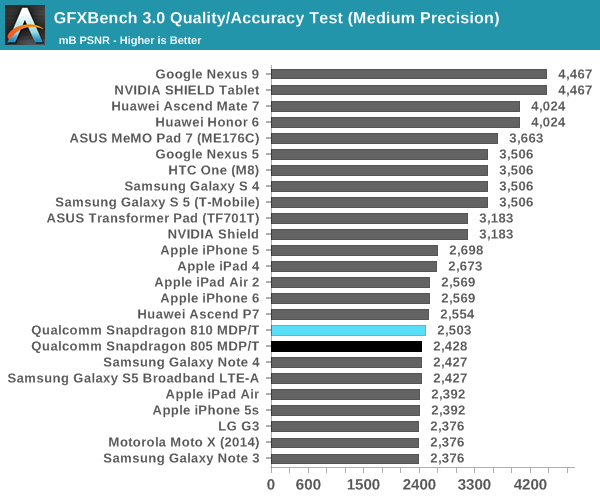

Finally, GFXBench's driver overhead and accuracy tests are more or less what we would expect for Snapdragon 810. In the case of driver overhead, a combination of newer drivers and a much faster CPU have reduced the CPU cost of driver overhead. Meanwhile with the underlying GPU architecture being unchanged, there are no material changes to quality/accuracy.
Overall then the performance gains for the Adreno 430 and Snapdragon 810 seem to be almost exclusively focused on shader performance, but in those cases where rendering workloads are shader bound, Qualcomm's 30% estimate is on the mark. Real-word performance gains meanwhile are going to depend on the nature of the workload; games and applications that are similarly shader-bound should see good performance gains, while anything that's bottlenecked by pixel throughput, texturing, or front-end performance will see much smaller gains. Thankfully for Qualcomm most high-end workloads are indeed shader bound, and this is especially the case when pushing high resolutions, as Qualcomm is trying to do with their 4K initiative for Snapdragon 810. However in the case of 4K, while Adreno 430 offers improved performance it's still slow enough that it's going to struggle to render any kind of decently complex content at that resolution.
As for Adreno 430 versus the competition, Qualcomm has narrowed much of the gap between themselves and NVIDIA/Apple, but they haven't closed it. Apple's Imagination GX6850 and NVIDIA's K1 GPUs continue to hold a performance advantage, particularly in GFXBench's Manhattan and T-Rex full rendering tests. Both Apple and NVIDIA invested significant die space in graphics, and while we don't know how much Qualcomm has invested in Adreno 430 with Snapdragon 810, it's safe to say right now that they would need to invest even more if they want to beat the graphics performance of NVIDIA and Apple's tablet SoCs.










119 Comments
View All Comments
warreo - Wednesday, February 18, 2015 - link
HAHAHA Tchamber you are a jewel. Thanks for making my morning. Here I was wondering if a week later anybody else had anything intelligent to say....Your analogy of the 5433 as a Lamborghini and the Snapdragons as Corvette/Camaro/GT500 is horrible. Period. Anybody who reads this site should know that. If you really want to get into an argument with someone, you should actually know what you're talking about before insulting them.
As for me, I wasn't talking to down to anyone. I gave AT my observations and also did in fact summarize my own conclusions if you'd bothered to read my comments in totality. Just because I disagree with them doesn't mean I'm talking down to them. You, however, should run along back to pre-school and learn how not to be a prick to others.
djvita - Thursday, February 12, 2015 - link
found some typoslast paragraph GPU performance "Qualcomm has narrowedmuch"
CPU performance
PNG Comp ST 0.82 MP/s 1110 MP/s 1.11 MP/s 35%
is 1110 correct? found the difference to be very high....
All in all, preliminar benchamrks looks good. Seems anandtech will need a flex2/mi note pro or the upcoming htc m9 in MWC (for sony no rumors, until july i think, lg g4 maybe in may. S6 wont be qualcomm)
Ratman6161 - Thursday, February 12, 2015 - link
Another typo:There are three tables at the top of the CPU Performance page. The last column in the first table says: Snapdragon % Advantage which clearly isn't correct because just in the first line the Samsung has about a 2 to one advantage it says the snapdragon advantage is 608%. I assume you actually meant this column to say but S810 > S805 % Advantage like in the second two tables.
djvita - Thursday, February 12, 2015 - link
they fixed them all now, it was 1.11SydneyBlue120d - Thursday, February 12, 2015 - link
Very interesting article. Do you think it is possibile the Galaxy S6 devices will use the MDM9x45 modem?deathBOB - Thursday, February 12, 2015 - link
Subjective impressions? Andrei pointed out that the Exynos was subjectively faster than the 805. How does the 810 fare?MrCommunistGen - Thursday, February 12, 2015 - link
Thanks for the informative article! The scope of the article as a whole goes far beyond a Preview of Snapdragon 810, specifically the sections on RF and Qualcomm's scheduler.That in mind, I'll hold off on passing judgement on S810's performance until we see shipping silicon. Between pre-release drivers and differences in chassis/thermals "Performance Preview" *is* spot on for the whole benchmarks section.
Even though S810 is Qualcomm's stopgap and there's only so much you can do (for better or worse) to the performance of off the shelf A57/A53 cores, I'm glad they're still in the game - or at least not out of it. Even as a preview, it is clear that Adreno 430's performance is more than just an iterative increase over Adreno 420.
Regardless of how S810 shakes out, I'm sure Qualcomm is baking all of their learnings from working on this SoC into their in-house ARMv8-A design
Mr.r9 - Thursday, February 12, 2015 - link
Even though this is a preview and drivers/Kernel will definitely improve....I still feel that the 810 will underwhelm.djvita - Thursday, February 12, 2015 - link
considering I still have an msm8960 device, this will be a huge jump for me.tviceman - Thursday, February 12, 2015 - link
This performance preview just reaffirms two of my beliefs.1) It's a shame that Nvidia couldn't get more products with Tegra K1 in it, seeing how K1 has been on the market for many months and generally outperforms the 805 (sometimes by a wide margin)
2) It's a shame that Tegra X1 will likely suffer the same limited release fate that Tegra K1 suffered, even if manufacturers were to downclock Tegra X1 to meet smaller TDP demands. X1, even if downclocked, will run circles around 805.